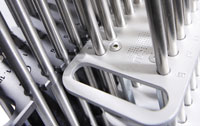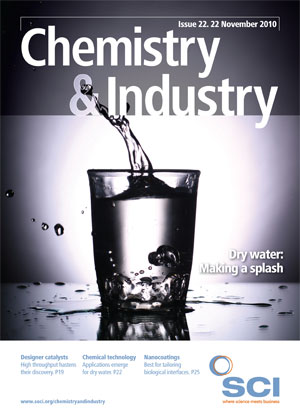One of the great things about catalysts is that even a slight improvement in their performance can be worth millions. So central are they to the chemical industry, essential in the synthesis of 80% of its products, that companies invest substantial amounts in developing new and improved versions. The rewards can be anything from substantial cost savings on existing syntheses to the development of entirely novel processes, which may be far cheaper or environmentally friendly than existing ones. New catalysts can lead to the development of new products or even markets.
‘Every percentage point that you improve the activity of a catalyst reduces the energy demand of the process, which really saves money for the industry,’ says Michael Paul, head of marketing at hte, a German catalyst design company. ‘If you produce 500m t of a chemical per year, just increasing the efficiency of the process by 1% will save millions of dollars.’
So it is unfortunate that new catalysts have proved incredibly difficult to develop, mainly because scientists had little idea about how they actually worked. They knew that some materials, such as metal oxides, in certain configurations were highly effective at speeding up chemical reactions, but they didn’t know why. As such, the process of developing new catalysts tended to involve much more trial and error than targeted design.
Now, though, things are beginning to change. A combination of advanced analytical techniques and computer modelling means that scientists are starting to get a much better understanding of how and why catalysts work. Meanwhile, catalysts are also beginning to benefit from high throughput techniques, allowing scientists to synthesise, screen and test more catalytic materials than ever before. The end results are new and improved catalysts that are already saving millions.
This lack of detailed understanding of catalytic workings extended to both heterogeneous catalysts, in which the catalyst is in a different phase to the reactants, and homogeneous catalysts, in which the catalyst and reactants are in the same phase.
Heterogeneous catalysts are the most widely used by industry, with the catalyst usually a solid and the reactants either gases or liquids. Homogeneous catalysts are less prevalent, but they tend to be inherently more efficient than heterogeneous catalysts. This is because, if the catalyst and reactants are all liquids or gases, then they can easily interact with each other, whereas solid catalysts can only interact with liquid or gaseous reactants at their surfaces.

For one of the problems with understanding catalysts is their sheer complexity. This is especially the case for heterogeneous catalysts, which tend to consist of various tiny metal particles embedded into some kind of solid matrix, which not only provides physical support but often plays an important role in a catalyst’s activity. Heterogeneous catalysts are also often capable of speeding up a whole suite of related reactions, only one or a few of which are usually of interest. Furthermore, those reactions often proceed through several steps, each of which can take a different length of time.
‘One of the problems with heterogeneous catalysis is, by its nature, you have a whole range of different active sites on a catalyst,’ says Stuart Taylor, who develops heterogeneous catalysts at Cardiff University’s new Cardiff Catalysis Institute. ‘You have many [chemical] species, which are there, and very often you’re not sure which of those species are giving you the chemistry that you want [and which] may be promoting side reactions. So you’re really trying to get into the catalyst mechanism: what are the features of the catalyst that give you the properties that you want.’

More recently, scientists have developed techniques that allow them to monitor in real time the various reactions taking place on catalysts. One of these techniques is a variation of TEM known as dynamic TEM (DTEM), in which a laser is fired at the surface of a catalyst closely followed by a beam of electrodes. The laser initiates chemical reactions on the catalyst, which are then probed by the beam of electrons, forming an image on a detector.
The results from these analytical studies on individual catalysts are now feeding into computer models, allowing scientists both to characterise these individual catalysts in more detail and also to uncover some general rules that apply to all catalysts. For example, in 2009 a US team of chemists led by Charles Campbell at the University of Washington, Seattle, introduced a mathematical concept known as the ‘general degree of rate control’, which provides a simple way to identify the rate-determining step in a catalytic reaction. ‘Often in a catalytic [reaction] you have several steps and one of these steps will be the slowest step,’ explains George Britovsek, who develops homogeneous catalysts at Imperial College London. ‘It’s important to identify that one; because once you know what is slowing you down, you can target that particular step.’
Having simple methods for identifying some of the fundamental characteristics of a catalyst, such as the rate-determining step, should greatly help in the development of new catalysts. But the latest computer models go beyond this. ‘From my point of view, modelling started off as another characterisation tool for a catalyst,’ says Taylor, ‘but the way modelling is now moving is probably more predictive.’
Scientists are almost getting to the point where they can design or customise catalysts on computer, allowing them to get an idea of how changes to the structure and chemical composition of a proposed catalyst may affect its activity, before going on to synthesise it in the laboratory.
‘We’re doing work on small gold clusters and gold bimetallic nanoparticles for a wide range of reactions and we work very closely with the modellers here,’ explains Taylor. ‘They’re developing models to try to help us to understand the [catalytic] mechanism and help us explain our results, and hopefully in a predictive way to tell us what kind of catalyst we need to prepare to get better performance.’
Computers are also a central component of another technology that is beginning to transform the development of new catalysts: high throughput screening. Here, automated systems are used to synthesise and screen a large number of different catalytic materials, in order to find those with the desired activity.
Founded in 1999, Heidelberg-based hte is a pioneer in this field, although it initially faced a great deal of scepticism. ‘When the founders of our company discussed this idea amongst the catalytic community, everybody said “Guys you are crazy; this can’t work”,’ says Paul.
No easy way to synthesise small quantities of lots of different catalytic materials
The reason for the scepticism was that at the time there was no easy way to synthesise small quantities of lots of different catalytic materials. Furthermore, heterogeneous catalysts tend to need high temperatures and pressures and often work with highly aggressive reactants, which means that any screening process had to be conducted under the same extreme conditions. Once again, the technology simply did not exist to do that. So hte set about developing it.
hte actually came up with a number of different approaches for developing suites of catalytic materials. In one approach, hte impregnated activated carbon, a highly porous material, with various different metal salt solutions. Burning the impregnated carbon then transforms the metal salts into catalytic metal oxides. Another approach involves sequentially attaching various populations of related catalytic molecules to tiny beads, with the end result being beads that possess every possible combination of the different molecules.
To screen these catalytic materials, hte developed systems of parallel reactor tubes, comprising 16, 32 or 48 tubes. To ensure that the tubes can withstand and contain the extreme conditions the catalytic materials are exposed to, they are separated from one another by super heat-conductive alloys.
The reactants are delivered to each of the tubes via a shared feed line or individually-controlled valves, while other valves and a robotic arm remove the gaseous and liquid end products for analysis by gas chromatography and mass spectrometry. The technology is very flexible, allowing different catalytic materials to be placed into each of the reactor tubes and all exposed to the same conditions or the same catalytic material to be placed into the tubes and then each exposed to different conditions.
Using this approach, hte claims the search for new catalysts can be carried out 100 times faster than was possible just a few years ago. It’s therefore not too surprising that hte already lists a string of major chemical companies as clients. These include the French chemical company Arkema, for which hte developed a new catalyst for converting glycerol, a major by-product of biodiesel production, into the industrial chemicals acrolein and acrylic acid; and CRI/Criterion, the catalyst subsidiary of the energy giant Shell, for which it developed a new styrene catalyst.
But this increase in the speed of catalyst discovery and development is obtained at a substantial financial cost, which means that this kind of high-throughput screening is mainly restricted to deep-pocketed chemical companies. Neither Taylor nor Britovsek currently have the resources to take advantage of it.
Nevertheless, scientists are busy developing other, potentially cheaper methods for synthesising and testing large numbers of catalytic materials. Bernhard Breit at the Albert-Ludwigs University in Freiberg, Germany, recently announced a method for producing and screening large numbers of the kind of metalbased complexes that make up homogeneous catalysts. This is based on producing families of related molecules that naturally pair up to bind to a central metal atom, creating a large population of similar catalytic molecules.
To screen these molecules, Breit has come up with a method in which the population of catalytic molecules is split into two and collectively tested, with the most active population then divided and tested again. This process is repeated until only the most active molecules remain. Comparing this approach with the much more long-winded process of testing the catalytic molecules individually, Breit found that both approaches identified the same catalysts as being most active.
Although this new technology looks set to transform the development of new catalysts, a word of warning comes from the pharmaceutical industry. It, too, has adopted similar computer modelling and high throughput techniques in the search for new drugs, but the results have so far been rather disappointing. Let’s hope that the developers of new catalysts have more success.
Jon Evans is a freelance science writer based in Chichester, UK





